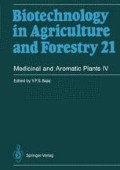Abstract
Thymus is a perennial herb of the Labiatae family (Fig. 1A) and can grow to a height of some 30 cm. There are more than 100 varieties of Thymus distributed throughout Europe. It has dark green leaves and light mauve-pink flowers in early summer. Thyme is a good rock-garden plant, as it spreads easily. It originates on the coast of the Mediterranean Sea and in the region of Asia Minor. Now it is cultivated in numerous European countries, Russia, Canada, America, and some of the North African countries. Thyme is one of the great culinary and medicinal herbs, and is a classic constituent of a bouquet garni (Fleming 1990), but only a few species are used in the kitchen, e.g., common thyme (T. vulgaris) and lemon thyme (T. citriodorus.) The essential oil (Marhuenda et al. 1988; Blazquez and Zafra-Polo 1989) of thyme has also been reported to be effective in food preservatives, antioxidants (Farag et al. 1990), antimicrobials (Morris et al. 1979), breath-freshen- ing dentifrices (Ishikawa and Shibuya 1989), medical disinfectants, etc. In general, the dried leaves contain 0.7–2.5% dry wt. of the essential oil. The major components are thymol (15–62%), carvacrol (2–44%), p-cymene, and γ-terpinene. The typical chemical structure is shown in Fig. 2.
Access this chapter
Tax calculation will be finalised at checkout
Purchases are for personal use only
Preview
Unable to display preview. Download preview PDF.
References
Acree TE, Barnard J, Cunningham DG (1984) The analysis of odor-active volatiles in gas chromatographic effluents. In: Schreier P (ed) Analysis of volatiles, methods, application. Walter de Gruyter, Berlin, pp 251–267
Blazquez MA, Zafra-Polo MC (1989) Essential oil analysis of Thymus godayanus, an endemic species growing in northeastern Spain. Pharmazie 44: 651
Croteau R (1981) Biosynthesis of monoterpenes. In: Porter JW, Spurgeon SL (eds) Biosynthesis of isoprenoid compounds, vol 1. Wiley & Sons, New York, pp 225–282
Farag RS, Ali MN, Taha SH (1990) Use of some essential oils as natural preservatives for butter. J Am Oil Chem Soc 67: 188–191
Fleming S (ed) (1990) Herbs. Mitchell Beazley, New York
Furmanowa M, Olszowska O (1992) Micropropagation of thyme (Thymus vulgaris L.). In: Bajaj YPS (ed) Biotechnology in agriculture and forestry, vol 19. High-Tech and Micropropagation III. Springer, Berlin Heidelberg New York, pp 230–243
Ishikawa M, Shibuya K (1989) Breath-freshening dentifrices containing copper gluconate, a fluorine compound, and alkyl sulfates. Eur Pat Appl 16
Kajiwara T, Hatanaka A, Kawai T, Ishihara M, Tuneya T (1987) Long chain aldehydes in the green marine algae Ulvaceae. Nippon Suisan Gakkaishi 53: 1901
Kajiwara T, Yoshikawa H, Saruwatari T, Hatanaka A, Kawai T, Ishihara M, Tsuneya T (1988) Enzymatic formation of unsaturated long chain fatty aldehydes in Ulva pertusa. Phytochemistry 27: 1643–1645
Kemp TR (1975) Characterization of some new C16 and CI7 unsaturated fatty aldehydes. J. Am Oil Chem Soc 52: 300–302
Marhuenda E, Menendez M, Lastra CA (1988) Constituents of essential oil of Thymus carrtosus Boiss. J Chromatogr 436: 103–106
Morris JA, Khettry A, Seitz EW (1979) Antimicrobial activity of aroma chemicals and essential oils. J Am Oil Chem Soc 56: 595–603
Nabeta K, Sugisawa H (1983) Volatile components produced by callus tissues from three Perilla plants. In: Charalambous G, Inglett G (eds) Instrumental analysis of foods. Academic Press, New York, pp 65–84
Nickerson GB, Linkers ST (1966) Gas chromatographic evidence for the occurrence of hop oil components in beer. J Chromatogr 21: 1–5
Poulose A J, Croteau R (1978) Biosynthesis of aromatic monoterpenes. Arch Biochem Biophys 187: 307–314
Sugisawa H, Miwa K, Matsuo T, Tamura H (1987) Volatile compounds produced from the cultured cells of thyme (Thymus vulgaris L.). In: Schreier P (ed) Bioflavour ’87. Walter de Gruyter, Berlin, pp 327–340.
Sugisawa H, Tamura H, Nakahara K (1988) The calculation program of retention index in gas chromatography. Nippon Shokuhin Kogyo Gakaishi 35: 709–712
Sugisawa H, Nakahara K, Tamura H (1990) The aroma profile of the volatiles in marine green algae (Ulva pertusa). Food Rev Int. 6: 573–589
Tamura H, Sugisawa H (1989) Calculation program of Kovats retention index values based on those of known compounds. Nippon Shokuhin Kogyo Gakaishi 36: 148–151
Tamura H, Kihara S, Sugisawa H (1990) A new identification method for aliphatic compounds using linear equations of the GC retention index value. Agric Biol Chem 54: 3171–3176
Yamamoto Y, Mizuguchi R, Yamada Y (1982) Selection of a high and stable pigment-producing strain in cultured Euphorbia millii cells. Theor Appl Genet 61: 113–116
Author information
Authors and Affiliations
Editor information
Editors and Affiliations
Rights and permissions
Copyright information
© 1993 Springer-Verlag Berlin Heidelberg
About this chapter
Cite this chapter
Tamura, H., Takebayashi, T., Sugisawa, H. (1993). Thymus vulgaris L. (Thyme): In Vitro Culture and the Production of Secondary Metabolites. In: Bajaj, Y.P.S. (eds) Medicinal and Aromatic Plants IV. Biotechnology in Agriculture and Forestry, vol 21. Springer, Berlin, Heidelberg. https://doi.org/10.1007/978-3-642-77004-3_27
Download citation
DOI: https://doi.org/10.1007/978-3-642-77004-3_27
Publisher Name: Springer, Berlin, Heidelberg
Print ISBN: 978-3-642-77006-7
Online ISBN: 978-3-642-77004-3
eBook Packages: Springer Book Archive

